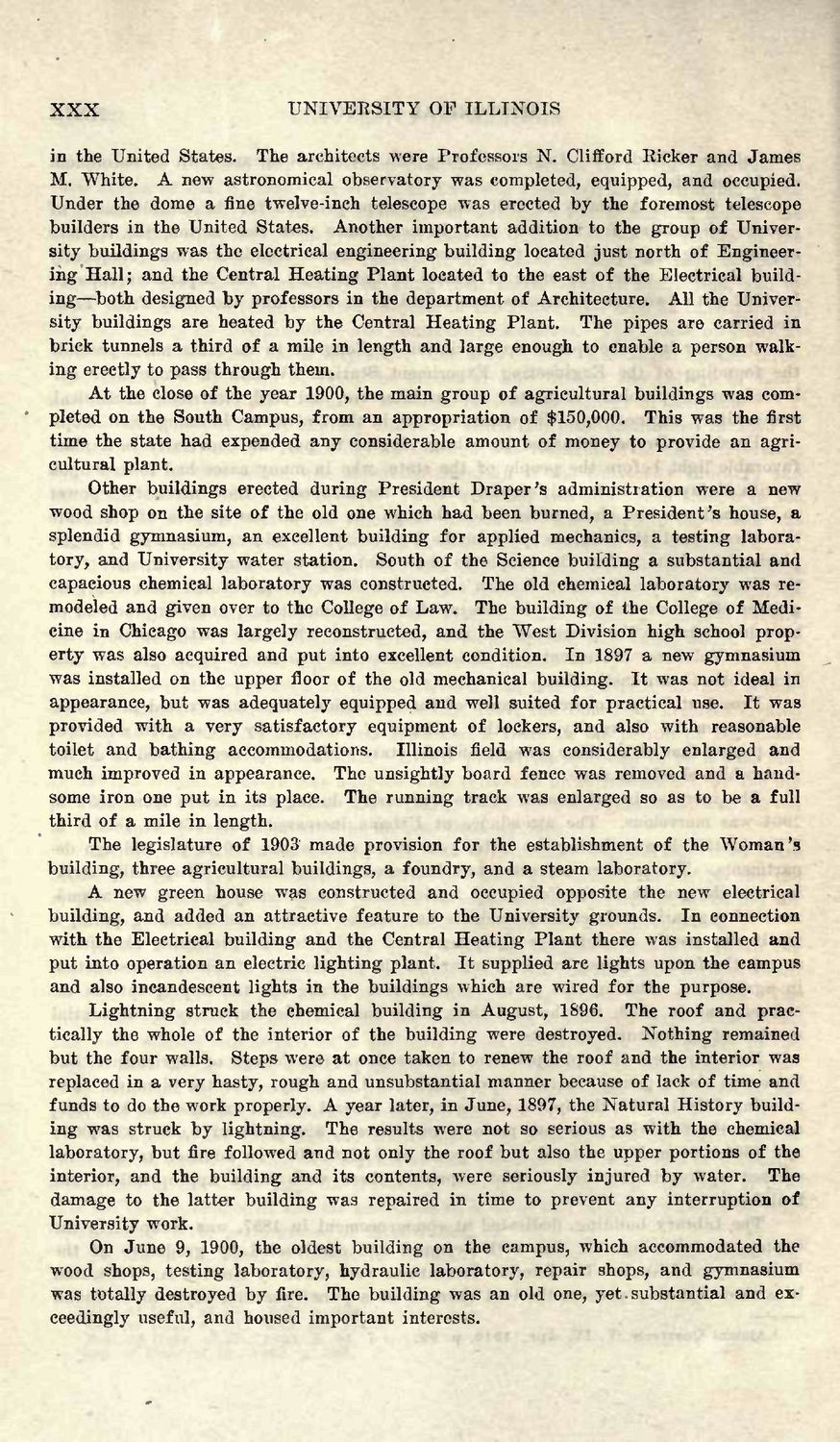| |
| |
Caption: Book - Early History of University (1916)
This is a reduced-resolution page image for fast online browsing.

EXTRACTED TEXT FROM PAGE:
XXX U N I V E R S I T Y OF I L L I N O I S in the United States. The architects were Professors N. Clifford Eicker and James M. White. A new astronomical observatory was completed, equipped, and occupied. Under the dome a fine twelve-inch telescope was erected by the foremost telescope builders in the United States. Another important addition to the group of University buildings was the electrical engineering building located just north of Engineeri n g ' H a l l ; and the Central Heating Plant located to the east of the Electrical building—both designed by professors in the department of Architecture. All the University buildings are heated by the Central Heating Plant. The pipes are carried in brick tunnels a third of a mile in length and large enough to enable a person walking erectly to pass through them. At the close of the year 1900, the main group of agricultural buildings was completed on the South Campus, from an appropriation of $150,000. This was the first time the state had expended any considerable amount of money to provide an agricultural plant. Other buildings erected during President Draper's administration were a new wood shop on the site of the old one which had been burned, a President's house, a splendid gymnasium, an excellent building for applied mechanics, a testing laboratory, and University water station. South of the Science building a substantial and capacious chemical laboratory was constructed. The old chemical laboratory was remodeled and given over to the College of Law. The building of the College of Medicine in Chicago was largely reconstructed, and the "West Division high school property was also acquired and put into excellent condition. In 1897 a new gymnasium was installed on the upper floor of the old mechanical building. I t was not ideal in appearance, but was adequately equipped and well suited for practical use. I t was provided with a very satisfactory equipment of lockers, and also with reasonable toilet and bathing accommodations. Illinois field was considerably enlarged and much improved in appearance. The unsightly board fence was removed and a handsome iron one put in its place. The running track was enlarged so as to be a full third of a mile in length. The legislature of 1903 made provision for the establishment of the Woman's building, three agricultural buildings, a foundry, and a steam laboratory. A new green house was constructed and occupied opposite the new electrical building, and added an attractive feature to the University grounds. I n connection with the Electrical building and the Central Heating Plant there was installed and put into operation an electric lighting plant. I t supplied are lights upon the campus and also incandescent lights in the buildings which are wired for the purpose. Lightning struck the chemical building in August, 1S96. The roof and practically the whole of the interior of the building were destroyed. Nothing remained but the four walls. Steps were a t once taken to renew the roof and the interior was replaced in a very hasty, rough and unsubstantial manner because of lack of time and funds to do the work properly. A year later, in June, 1897, the Natural History building was struck by lightning. The results were not so serious as with the chemical laboratory, but fire followed and not only the roof but also the upper portions of the interior, and the building and its contents, were seriously injured by water. The damage to the latter building was repaired in time to prevent any interruption of University work. On June 9, 1900, the oldest building on the campus, which accommodated the wood shops, testing laboratory, hydraulic laboratory, repair shops, and gymnasium was totally destroyed by fire. The building was an old one, yet.substantial and exceedingly useful, and housed important interests.
| |